Sold Ceramics
Sold Famille Verte wares 1680-1725
Tea, Coffee and Chocolate wares
Page 1
Several types of polychrome enamelled porcelain were developed from c.1680, during the reign of Emperor Kangxi (1662–1722). The so-called famille verte type, its decoration dominated by green enamels, was particularly popular in Europe from c. 1690–1720. The use of blue overglaze enamel was a new phenomenon, but gold was more frequently applied too. Details and outlines are often in black. It is remarkable that verte is rarely combined with underglaze blue. Apparently, the shaping and firing took place in factories in Jingdezhen that were different from the workshops where the enamelling took place.
Besides dishes, plates and bowls, luxury items such as monteiths (glass coolers) were also made. These Western shapes were modelled after pewter, glass or earthenware models. However, Western shapes occur infrequently, while Western decorations are almost non-existent. The usual Chinese decorations show a variety of flowers, animals, landscapes and figurative scenes. Much famille verte was also made for the domestic Chinese market, not just for export. Therefore, many figural decorations are based on Chinese literary sources, copying the woodcut illustrations in novels and plays. For the Western owner these decorations were nothing more than highly exotic, but for the Chinese there were all kinds of intellectual connotations. Only recently have Western scholars started investigating their meanings. One popular theme used on porcelain was the 'Western Chamber', a love story still popular today. Remarkably, European depictions in famille verte are rare.
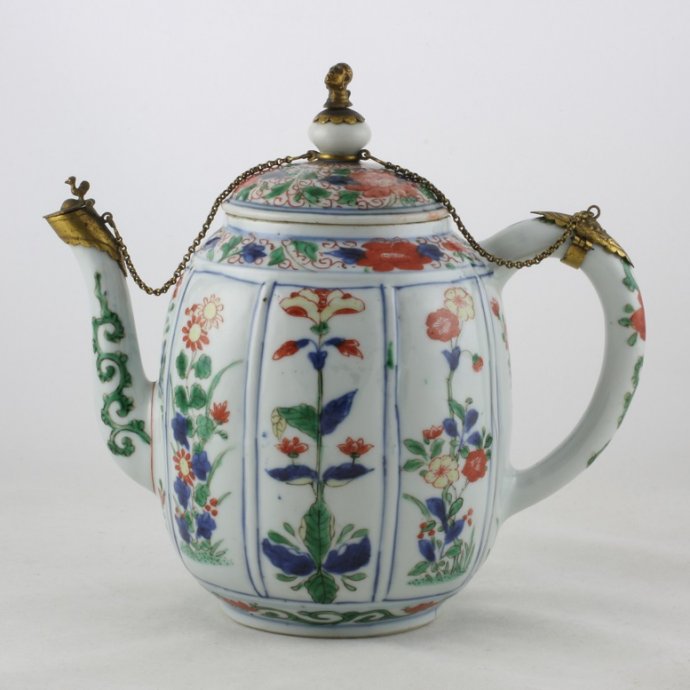
Sold Ceramics - Sold Famille Verte wares 1680-1725 - Tea, Coffee and Chocolate wares - Page 1
Object 2011912
Teapot
China
c.1700
Height with cover and mounts 170 mm (6.69 inch), height without cover 125 mm (4.92 inch), diameter handle to spout 195 mm (7.68 inch), diameter of mouthrim 61 mm (2.40 inch), diameter of footring 59 mm (2.32 inch), weight including cover 562 grams (19.82 ounce (oz.)), weight of cover with mounts 72 grams (2.54 ounce (oz.))
Teapot of eight-lobed melon form on a footring. Rising spout and a C-shaped handle. Domed cover with round knob. Decorated in underglaze blue and famille verte enamels in close imitation of Japanese Kakiemon-style ware. The upright panels are framed in underglaze blue lines and enamelled with various flowering plants. On the shoulder and on the cover flower scroll borders. Around the foot, on the spout and handle lotus-scroll foliage. The knob of the cover is fitted with a gilt over silver finial shaped in the form of a Moors head. The cover is secured by a chain to the mount on the handle engraved with flowers and to cover on the spout with a standing rooster.
There are very few examples of direct Chinese copying of Kakiemon-style wares. They were no doubt made to meet a Western demand, for Japanese tea-making procedures did not require such a pot. The probability is that most of them were made for the foreign market soon after 1700 to compete, like the Chinese Imari wares, with Japanese originals. The Chinese version will have been supplied to the Dutch in Batavia, if not to European traders at other entrepôts. Interestingly, the blue enamel on the Japanese teapot is replaced by underglaze blue on the Chinese version (Jenyns 1979, p.33, p.58,p.129,p.153), (Ayers, Impey & Mallet 1990, p. 234)
In Europe ormolu caps surmounted by figures of animals and connected by chains were fitted to the pot's handle, finial and spout in about 1720. This prevented the lid being lost or dropped while also enhancing the pot's luxurious appearance. (Düsseldorf 2015, p.169)
Teapot and lid, with European gilt metal mounts, Japan, 1680-1700, the mounts contemporary and probably Dutch. Ashmolean Museum Oxford England, 1978.658, Reitlinger gift. © Ashmolean Museum, Oxford, England. (this teapot and cover are not included in this sale/offer and serve only as an example)
An identically shaped, sized and decorated teapot is the collection of Augustus the Strong in Dresden and registered under the number P.O. (Porzellan Ostasien) 6080. For this teapot, please see;
For Japanese Kakiemon decorated teapots, which in shape and decoration served as examples for the few Chinese Kangxi famille verte decorated teapots. please see:
- Japanese Porcelain, (S. Jenyns, Faber & Faber, London / Boston, 1979), cat. 78a, (the Fitzwilliam Museum, Cambridge)
- The Wrestling Boys. Chinese and Japanese Ceramics from the 16th to the 18th Century in the Collection at Burghley House, (The Trustees of Burghley House, Stamford 1981), p.27, cat. 78.
- Porcelain for Palaces. The Fashion for Japan in Europe 1650-1750, (J. Ayers, O. Impey & J.V.G. Mallet, Oriental Ceramic Society & The British Museum, London 1990), p.145 cat. 110. (with mounts very similar to this Chinese teapot)
- Japanese Export porcelain. Catalogue of the collection of the Ashmolean Museum, Oxford, (O. Impey, Hotei Publishing, Amsterdam, 2002), p.125, cat. 159.
For identically shaped and decorated Chinese teapots in Kakiemon-style, please see:
- Japanese Porcelain, (S. Jenyns, Faber & Faber, London / Boston, 1979), cat. 78b,
- Chinesisches und japanisches Porzellan in europäischen Fassungen, (D.F. Lunsingh Scheurleer, Verlag Klinkhardt & Biermann, Braunschweig,1980), p.240, Abb. 135. (this teapot is part of the famous collection of August the Strong in Dresden, Germany)
- Japanese porcelain. A collector's guide to general aspects and decorative motifs, (P.L.W. Arts, De Tijdstroom, Lochem, 1983), p.65, Plate 38.
- Porcelain for Palaces. The Fashion for Japan in Europe 1650-1750, (J. Ayers, O. Impey & J.V.G. Mallet, Oriental Ceramic Society & The British Museum, London 1990), p.234 cat. 252.
Condition: A hairline originating from the base and ending to the side.
References:
Jenyns 1979, p.33, p.58, p.129, p.153 & cat. 78a & 78b.
Lunsingh Scheurleer 1980, p.56 & Abb. 135
Ayers, Impey & Mallet 1990, cat. 110 & cat. 252
SKD Online collection, PO. 6080
Price: Sold.
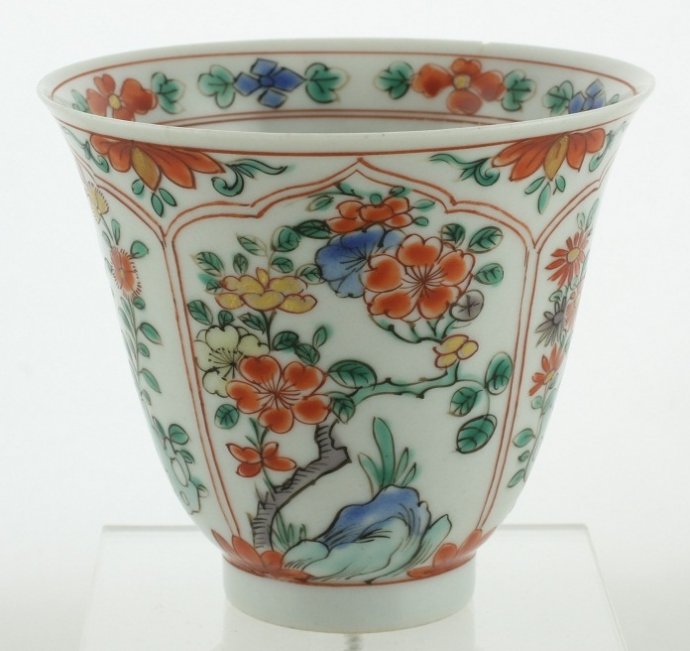
Sold Ceramics - Sold Famille Verte wares 1680-1725 - Tea, Coffee and Chocolate wares - Page 1
Object 2010742
Chocolate beaker
China
c.1700
Height 71 mm (2.79 inch), diameter of mouthrim 79 mm (3.11 inch), diameter of footring 37 mm (1.46 inch)
Chocolate beaker on footring, a steep wall with flaring rim. Decorated in various overglaze famille verte enamels with on the outside four panels filled with various flowering plants growing from rockwork. On the rim four half flower heads. Around the inside rim a border of eight flower heads, on the bottom a single flowering stem. Marked on the base with a square shop mark in a double circle, underglaze blue.
Cocoa was first brought to Europe by the Spaniards from Mexico in the 1st half of the 16th century. From Spain the cocoa beans were traded to Italy and The Netherlands, First used as a medicine, later at the end of the 17th century it was consumed as a pleasure drink. In 1722 Father d'Entrecolles already mentioned, high chocolate cups/beakers, in his letters. (Jörg & Van Campen 1997, p.116)
This chocolate beaker was originally part of a chocolate set together with a matching saucer and / or cover both now missing.
Condition: Three short hairlines to the rim, one with a tiny fleabite.
Reference:
Jörg & Van Campen 1997, cat. 117
Price: Sold.
Not illustrated object 2010877B, another identically shaped, sized and decorated, sold chocolate beaker.
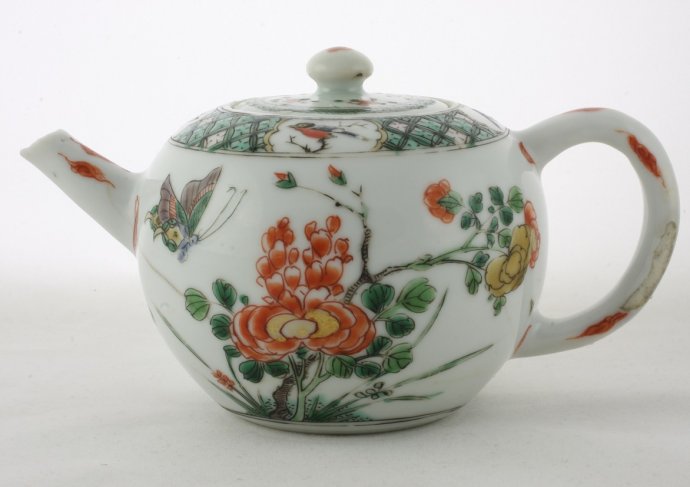
Sold Ceramics - Sold Famille Verte wares 1680-1725 - Tea, Coffee and Chocolate wares - Page 1
Object 2011335
Teapot
China
1700-1720
Height with cover 91 mm (3.58 inch), height without cover 74 mm (2.91 inch), diameter handle to spout 162 mm (6.38 inch), diameter of mouthrim 55 mm (2.17 inch), diameter of footring 50 mm (1.97 inch)
Globular teapot on a footring. Straight spout and a curved C-shaped handle. The inlaying flat cover with round knob. Decorated in famille verte enamels with flowering plants and butterflies in flight. Around the mouth a broad border with a trellis pattern ground with four cartouches with each a magpie perched on a branch or in flight in between half rosettes. On the cover four flowering branches, round the edge a zig-zag pattern border. On the knob a single flower head. The handle and spout are decorated with stylized cloud motifs. The cover has been pierced.
Only grown in China and Japan during the 17th Century, tea became known in the Netherlands early because the Dutch East India Company (VOC) shipped small quantities home. Its use as a beverage was established slowly, and was probably started by retired VOC employees who had become accustomed to drinking tea in the East. At a tea party, the expensive beverage was served in small teapots, one for each guest, filled with the leaves of the type he or she preferred. The tea was poured into small cups, while the teapot was refilled with hot water from a metal or sometimes ceramic kettle. The small quantity of famille verte teapots still abound reflects the demand in Europe at the time. Elaborately decorated, they must have been regarded as luxury wares for the upper classes. (Jörg 2011/2, p.131)
For similarly decorated teapots, please see:
- Chineesche Ceramiek. Handboek. Geschreven naar aanleiding van de verzameling in het museum het Princessehof te Leeuwarden, (N. Ottema, N.V. Drukkerij en Uitgeverij J.H. de Bussy, Amsterdam 1943), p.196, cat. 225.
- Aziatische ceramiek uit vijf eeuwen, (D.F. Lunsingh Scheurleer, exhibition catalogue of the J.M. van Diepen Collection, Fraeylemaborg Slochteren, 1977), p.56, cat. 142.
- Famille Verte, Chinese Porcelain in Green Enamels, (C.J.A. Jörg, Schoten, 2011), p.134, cat. 122.
Condition: A large "V"-shaped circular firing crack around the base, Two unglazed spots and a firing hairline to the handle, A rough spot to the tip of the spout, Some frits and chips to the rim of the cover.
References:
Lunsingh Scheurleer 1977, cat. 142
Jörg & Van Campen 1997, pp.199-200
Price: Sold.

Sold Ceramics - Sold Famille Verte wares 1680-1725 - Tea, Coffee and Chocolate wares - Page 1
Object 2010743
Saucer
China
1700-1720
Height: 24 mm (0.94 inch), diameter of rim 113 mm (4.45 inch), diameter of footring 60 mm (2.36 inch), weight 104 grams (3.67 ounce (oz.))
Saucer on footring, slightly everted rim. Decorated in various famille verte enamels with flowering plants growing from pierced rockwork and flying butterflies and insects, round the rim a spiral pattern border. Marked on the base with the symbol mark, Artemisia leaf, in overglaze iron-red, in a double circle in underglaze blue.
Condition: A chip to the footring and some small frits to the rim.
Price: Sold.
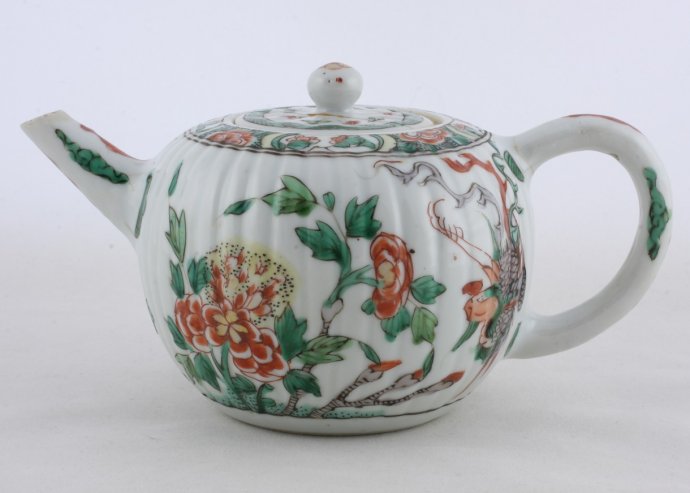
Sold Ceramics - Sold Famille Verte wares 1680-1725 - Tea, Coffee and Chocolate wares - Page 1
Object 2012318
Teapot
China
c.1700
Height with cover 90 mm (3.54 inch), height without cover 70 mm (2.76 inch), diameter handle to spout 167 mm (6.57 inch), diameter of mouthrim 52 mm (2.05 inch), diameter of footring 51 mm (2.00 inch), weight including cover 341 grams (12.02 ounce (oz.)), weight cover 24 grams (0.85 ounce (oz.))
Globular ribbed teapot on a footring. Straight spout and a curved C-shaped handle. The inlaying flat cover with round knob. Decorated in famille verte enamels with on each side flowering plants and a large phoenix in flight. Around the mouth a broad border with four cartouches, each filled with flower sprays, on a green-speckled ground with half rosettes. The handle and spout are decorated with stylized cloud motifs. On the cover four lozenges alternating with asterixis within a zig-zag-pattern border. On the knob a single flower head. The cover has been pierced.
Although drinking Chinese tea had become a widespread habit all over Europe, it was still a beverage of the upper classes in the early 18th century. The better qualities especially were real luxuries and therefore expensive. During a tea party several types and qualities of tea were offered. Usually they were served in small cups and each guest had his or her own relatively small teapot with the chosen type of tea. In tea shops, too, small or miniature teacups and teapots were used to enable buyers to taste various kinds of tea and make their choice. (Jörg & Van Campen 1997, pp.199-200)
Condition: Some firing tension hairlines around the spout and to the attachments of the handle to body all caused by the firing process. A chip to the inlaying mouthrim. The cover has been broken.
Reference:
Price: Sold.
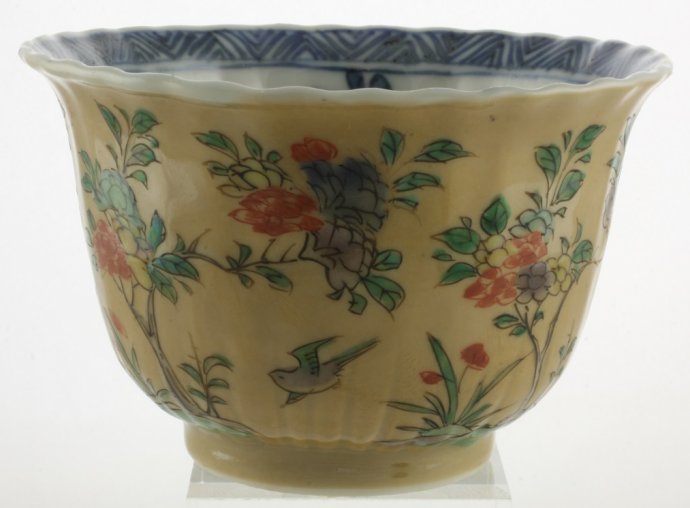
Sold Ceramics - Sold Famille Verte wares 1680-1725 - Tea, Coffee and Chocolate wares - Page 1
Object 2011264
Cup
China
c.1700
Height 52 mm (2.04 inch), diameter of rim 80 mm (3.14 inch), diameter of footring 38 mm (1.50 inch)
Cup on footring, slightly everted rim with a lobbed edge. Covered with a light-brown (café au lait) glaze and decorated in famille verte enamels, with black and iron-red. The interior rim, wall and bottom in underglaze blue. Decorated with four groups of wide spreading flowering plants and birds in flight in between. Round the inner rim a border of zig-zag lines and on the interior wall four peony sprays in underglaze blue. On the bottom three flowering plants with flying insects. Marked on the base with the symbol mark, "Sacred Fungus", the symbol of longevity, immortality, in a double circle in underglaze blue.
These relatively large cups could be used for tea as well as coffee. The designs are well painted with attention to detail, so these cups are a good example of the high quality tea and coffee wares decorated in famille verte colours that were ordered by the Dutch from c.1700 onwards. (Jörg & Van Campen 1997, p.172)
Condition: A firing flaw with a short connected glaze hairline to the rim and some wear to the enamel.
References:
Jörg & Van Campen 1997, cat. 192
Jörg 2011/2, cat. 128,129,133 & 138
Price: Sold.
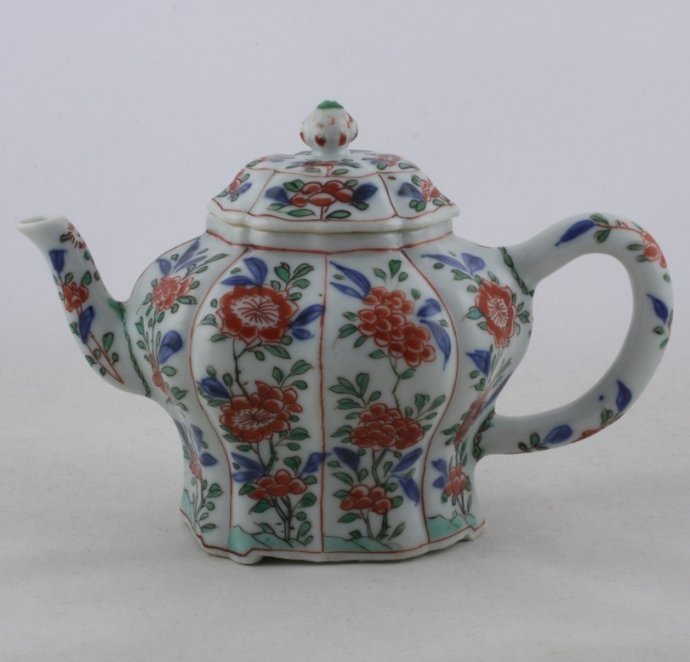
Sold Ceramics - Sold Famille Verte wares 1680-1725 - Tea, Coffee and Chocolate wares - Page 1
Object 2011268
Teapot
China
c.1700
Height with cover 112 mm (4.41 inch), height without cover 82 mm (3.35 inch), diameter handle to spout 163 mm (6.42 inch), dimensions of mouth 42 mm (1.65 inch) x 52 mm (2.04 inch), dimensions of foot 60 mm (2.36 inch) x 66 mm (2.60 inch), weight including cover 285 grams (10.05 ounce (oz.)), weight of cover 38 grams (1.34 ounce (oz.))
Teapot with fluted baluster sides supported on three short feet. S-shaped spout and C-shaped handle. Fluted domed cover. Decorated in underglaze blue and famille verte enamels with several panels filled with flowering plants and insects. On the handle and spout flower sprays. The cover is decorated en suite.
In the late 19th century the French art historians Albert Jacquemart and Edmond le Blant coined the term famille verte for this form of polychrome porcelain; in China it is called Kangxi wucai by analogy with wucai (five colours) ware from the Ming dynasty. The 'five' refers not to five specific colours but to 'all' colours. (Düsseldorf 2015, p,158)
Condition: The body restored after being broken in two pieces. The cover with a firing flaw and some glaze loss to the tip of the knob.
Reference:
Price: Sold.
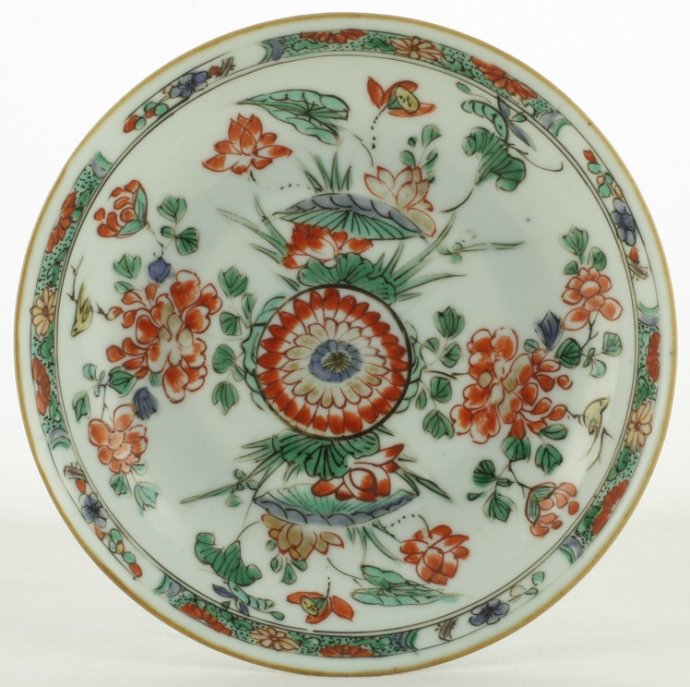
Sold Ceramics - Sold Famille Verte wares 1680-1725 - Tea, Coffee and Chocolate wares - Page 1
Object 2010814
Saucer
China
1700-1720
Height 26 mm (1.02 inch), diameter of rim 135 mm (5.32 inch), diameter of footring 62 mm (2.44 inch)
Saucer on footring, slightly everted rim. Decorated in various overglaze famille verte enamels with a central chrysanthemum flower head surrounded by four groups of flowering plants and two bird perched on branches. On the rim a border of flower heads reserved on a green-speckled ground with four reserves filled with flowering branches. The reverse is undecorated.
Condition: Two hairlines to the rim.
Price: Sold.

Sold Ceramics - Sold Famille Verte wares 1680-1725 - Tea, Coffee and Chocolate wares - Page 1
Object 2010454
Teacup
China
c.1700
Height 40 mm (1.58 inch), diameter of rim 70 mm (2.76 inch), diameter of footring 31 mm (1.22 inch)
Teacup on footring with an undulating rim. Decorated in various overglaze famille verte enamels, iron-red and gold. On the outside birds in flight in between flowering aster plants growing from rockwork. On the bottom two birds in flight in between flowering aster plants growing from rockwork the sides with three flower sprays and around the inside rim a zig-zag lines pattern border. Marked on the base with the symbol mark: 'Hare', symbol of intelligence and longevity, in a double circle, underglaze blue.
Condition: A chip to the inner footring, two tiny hairlines and two very tiny fleabites to the underside of the rim.
Reference:
Price: Sold.

Sold Ceramics - Sold Famille Verte wares 1680-1725 - Tea, Coffee and Chocolate wares - Page 1
Object 2012164A
Teapot
China
1700-1720
Height 105 mm (4.13 inch), diameter ear to spout 146 mm (5.75 inch), diameter of mouthrim 45 mm (1.77 inch), diameter of footring 53 mm (2.09 inch), weight with cover 264 grams (9.31 ounce (oz.)), weight cover 37 grams (1.31 ounce (oz.))
Teapot on footring, moulded body and cover, straight spout and C-shaped handle. Domed cover with round knob. Decorated in underglaze blue, overglaze iron-red and black and green enamel with six shaped panels each filled with various flowering plants growing from rockwork, on the shoulder a descending pointed leaves-pattern border and on the neck a zig-zag lines pattern border. On the cover a descending pointed leaves-pattern border. Handle and spout with florets between scrolls.
Toward the end of the 17th century, stimulated by commissions from the court in Peking, the porcelain factories began to experiment with new glazes and decoration techniques. One of the methods developed at that time was the application of decorations along with glazes coloured by metal oxides, the so-called 'enamel'. To apply the decoration, the object had to be first glazed and fired. Then the enamel could be applied and the object was inserted into the kiln for a second time.
One of the types of porcelain thus decorated, in which a green-tinted enamel is prominent, is commonly referred to as famille verte. And naturally, the variant in which pink dominates the decoration was allocated the name famille rose. The verte type was produced from the second half of the 17th century onward, while the rose variant appeared on the market later, in around 1725. (Source: Breekbaar Goed. Een eerbetoon aan Minke A. de Visser (1989-1966), exhibition held at the Groninger Museum, Groningen, 20 March 2015 - 15 March 2016)
Only grown in China and Japan during the 17th Century, tea became known in the Netherlands early because the Dutch East India Company (VOC) shipped small quantities home. Its use as a beverage was established slowly and was probably started by retired VOC employees who had become accustomed to drinking tea in the East. At a tea party, the expensive beverage was served in small teapots, one for each guest, filled with the leaves of the type he or she preferred. The tea was poured into small cups, while the teapot was refilled with hot water from a metal or sometimes ceramic kettle. The small quantity of famille verte teapots still abound reflects the demand in Europe at the time. Elaborately decorated, they must have been regarded as luxury wares for the upper classes. (Jörg 2011/2, p.131)
Condition: A shallow chip with a short-connected hairline to the tip of the spout, some very tiny spots on the rim of the cover, caused by popped bubbles of glaze during the firing process.
Reference:
Breekbaar Goed. Een eerbetoon aan Minke A. de Visser (1989-1966), exhibition held at the Groninger Museum, Groningen, 20 March 2015 - 15 March 2016)
Price: Sold.
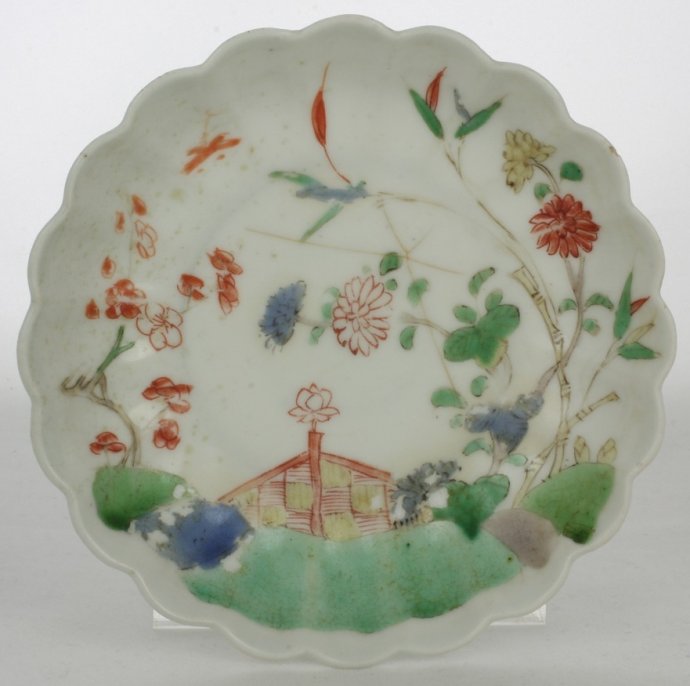
Sold Ceramics - Sold Famille Verte wares 1680-1725 - Tea, Coffee and Chocolate wares - Page 1
Object 2010604
Saucer
China
c.1700
Height 24 mm (0.94 inch), diameter of rim 110 mm (3.94 inch), diameter of footring 59 mm (2.32 inch)
Saucer on footring, curved sides and rim with a lobbed edge. Decorated in various overglaze famille verte enamels with a lotus flower by a fence surrounded by flowering bamboo, chrysanthemum, and prunus plants with a single flying butterfly. Marked on the base with the symbol mark: Lotus, in a double circle, underglaze blue.
Condition: A frit to the rim, a X-shaped hairline to the base and wear to the enamels on various spots.
Price: Sold.

Sold Ceramics - Sold Famille Verte wares 1680-1725 - Tea, Coffee and Chocolate wares - Page 1
Object 2011379
Saucer
China
1720-1740
Height 27 mm (1.06 inch), diameter of rim 122 mm (4.80 inch), diameter of footring 68 mm (2.68 inch), weight 96 grams (3.39 ounce (oz.))
Saucer on footring, scalloped sides and rim. Decorated in various famille verte enamels with a single flower head in a concentric band. The sides and rim with different flowering plants growing from pierced rockwork near a fence. The reverse with two flower sprays. On the base a rectangular paper label that reads; 'FAMILLE VERTE, K'ang Hsi (1662-1722)'.
Condition: A frit with a short connected hairline to the rim.
Price: Sold.


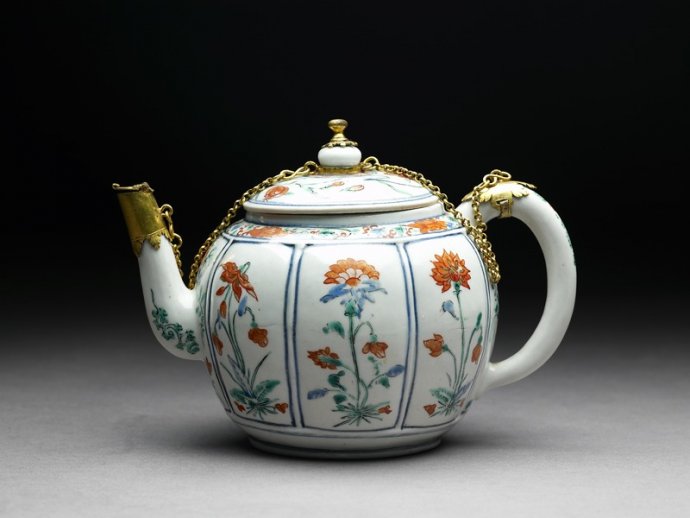
.jpg?1495278446139)
 create websites
create websites